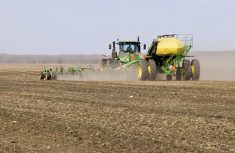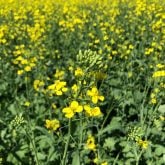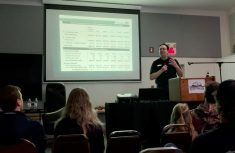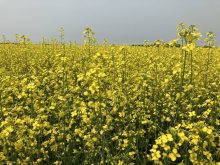Southwest region
Cool and constant wet weather is stalling harvest progress. Rainfall amounts of 10 to 50 mm, majority falling during thunderstorms, which also resulted in hail. Snowfall is also reported in northern parts of the region and near the Saskatchewan border. Lodging in canola and other crops is common. Overnight temperatures ranged from zero to -5 C, which is speeding maturation of soybeans, sunflowers and corn.
Overall harvest progress in the October 2016-2018 Averages from Manitoba Crop Report.
- Click here for the Crop Weather Report for the week ending Sept. 30
Read Also

Manitoba sclerotinia picture mixed for 2025
Variations in weather and crop development in this year’s Manitoba canola fields make blanket sclerotinia outlooks hard to pin down
Southwest is 58 per cent complete. Corn at dent stage (R5). Some producers are considering silaging corn soon, but most are holding off until crop moisture come down, rain stops and fields dry. Grain corn needs another week of nice weather to accumulate enough heat units to reach physiological maturity. Corn yields are expected to be average, but with wet grain.
Canola is mostly swathed or ready to straight harvest. More producers are choosing to straight cut fields versus swath. Canola harvest is 45 per cent complete with yields of 40 to 50 bu/ac. Yield losses in both swath and standing canola from wind and hail.
Spring Wheat is 75 to 80 per cent harvested, in most areas. Quality may be a major concern for crops with high grain moisture and lack of aeration in storage. Grain quality is deteriorating quickly in swathed cereals, still laying on the ground. Oat harvest is 95 per cent complete, but some lodged crops remain.
Soybeans mostly mature, reaching R8 stage. Frost during last week helped most of fields to complete the maturity. No harvest progress yet. There are some reports of hail damage in soybean in southern parts of the region. Flax crop looking promising but no reports of harvest yet. Sunflowers are at R8. Head and basal rots are occurring with high moisture conditions.
Winter cereals are germinating well. Plenty of soil moisture available now.
Continued rain and cool weather has halted harvesting of greenfeed, silage and straw in most of the region. The north half of the region is faring better for late harvest, as they have not received the quantity of rain over the last few weeks. However, production in the north is lower, in general, as they were drier over the growing season. Producers are continuing to feel the pressure of not being able to put up a final feed source. A week of good weather is needed to move forward with harvest. Cattle are mostly still on pasture, some with supplementation. Sloughs and dugouts are recharging and many areas that have been dry all summer now have standing water.
Northwest region
Cool weather with intermittent rain showers during the week. Rainfall totalled 20 to 29 mm in the region with the exception of The Pas where there was only a trace amount of precipitation. The Northwest region had the first killing frost of the season at the end of the week; the coldest temperature was minus 5.5°C at Inglis. There was heavy snow in the Swan River area early Tuesday with accumulations of 2 to 10 cm. In spite of challenging weather, producers are managing to advance harvest with overall progress estimated at 70 per cent.
Spring wheat harvest is 90 per cent complete. Yields at Roblin and The Pas are in the range of 60 to 90 bu/ac, while at Swan River yields are 50 to 75 bu/ac. Some of the wheat is coming off at high moisture and is being dried and/or aerated. The canola crop is either swathed or standing for straight combining. The heavy wet snow at Swan River knocked down some of the standing canola in that area.
Canola harvest advanced with overall progress at 65 per cent complete. Roblin and Swan River are 65 per cent complete; operations are just beginning on canola harvest at The Pas. Reported yields are in the 40 to 60 bu/ac range at Roblin and 55 to 70 bu/ac around Swan River. The killing frost ended soybean crop growth. Soybeans remain standing around Roblin; at Swan River and Ste. Rose harvest is just underway at 5 per cent complete. Oats are 75 per cent complete at Swan River and 50 per cent at Roblin. As for flax, 100 per cent of the crop remains standing. Where soil moisture conditions are suitable, post harvest operations are underway on harvested fields.
Baling of straw continued this week where conditions allowed. Some late seeded greenfeed crops remain to be harvested when weather conditions are suitable. Frost on the weekend halted growth in pastures and hay fields for the year. With pasture conditions deteriorating, supplementation has started particularly in continuously grazed pastures. Nitrates can be a concern in late seeded standing greenfeed crops and in annual regrowth that producers had planned to use for extending grazing with the recent cold temperatures. It is anticipated that some alfalfa fields will be harvested if weather cooperates. Corn silage harvest has just begun with although many fields still require dry down to reach proper moisture before chopping.
Central region
Another week of rainy cool weather that limited harvest to a few partial days in between rains. Precipitation ranged from a low of 30 mm around Cartwright to 70 mm near Altona. Most areas received 40 to 50 mm. Localized hail accompanied a cold system that moved in midweek. Damage varies from light in some areas to severe in some fields near Notre Dame de Loudres.
Harvested grain is usually tough and must be put on aeration or dried before longer-term storage. Soil moisture is rated as good to excessive with the recent rains. The slow rate of rainfall allowed for good infiltration of the water but the excessive amounts received is accumulating in low-lying areas of fields and filling up ditches.
Frost reported on Saturday and Sunday mornings with temperatures dipping to -1 to -2 C in many locations.
Overall harvest is estimated at 70 to 75 per cent complete. Harvest of wheat, oats and barley is considered done in the Red River Valley, whereas 5 per cent of the wheat remains to be harvested west of the escarpment. Ripe, mature, unharvested wheat is suffering from this last stretch of wetness causing bleaching, some sprouting and downgrading grain quality. Earliest harvested wheat is of good grade. Protein levels reported vary from 14 to 15.5 per cent.
Tillage and manure applications are delayed due to wet field conditions. Volunteer grain regrowth is evident having good germination conditions. Emergence of planted winter cereals is slow due to the cool temperatures but uniform with the abundant moisture.
Corn is in the later grain filling stage. More advanced and well- developed corn crops are dented and nearing physiological maturity. Silage corn harvest continues where field access is possible. Some poorer fields destined for grain are being harvested as silage.
Soybeans at R8 or full maturity and ready to be harvested in the Red River Valley. West of the escarpment, soybean fields are mature but need more drying down before they can be harvested. No harvest of done during the week. Earlier yield reports in the Red River Valley reported in the 30 bu/ac range and considered below average. There were reports of pod and stem blight on mature soybeans and in some case quality damage reported on harvest samples. Lesions can be found as black spots on the stems and pods. In case where the pod has opened, black lesions can be found on the seeds that affects the quality of the soybeans.
Dry beans are podded and mature. About 30 to 40 per cent of field beans have been harvested to date with average yield between 1500 to 1800 lbs/ac. Due to the recent rains, quality may now be affected on unharvested samples.
Canola swathing is done. Standing canola dries quicker and could be combined this week whereas swathed canola remained too wet to harvest. Sprouting is reported in some swathed canola. Canola harvest is 95 per cent complete in the valley while above the escarpment canola harvest is 65 per cent done with yields reported in the 40 to 50 bu/ac range. Flax is in the boll stage, brown and harvest underway with 25 to 35 bu/ac yields reported to date. Sunflower is in the R8 stage and seed filling.
Commercial potato harvest is underway but stalled with the wet conditions. Reports of 30 to 60 per cent harvest complete in different areas.
Above average rainfall in the last month has recharged soil moisture on crop, hay and pasture land. Forages will benefit the most from the September rains. Second and third-cut hay fields and pastures have greened up and are providing fall grazing. This will be limited as cooler weather and frost will soon end fall growth. Re-growth has been affected by the earlier dry conditions, which stressed the forages.
Corn silage harvest has begun where fields are dry enough to travel. Hay production overall is below average due to the dry conditions in spring and summer. Hauling of hay and straw into feed yards will be delayed until the ground dries up. The improvement in forage growth will help extend the grazing season and delay the feeding of winter feed supplies. Calves are being creep fed on pasture.
Eastern region
Rainfall accumulations for the week across the Eastern region ranged from 40 to over 70 mm. Rainfall amounts were highest in southern and central districts of the Eastern region. Fields are wet to saturated and standing water apparent. Harvesting has stopped although progress in canola and soybeans was made from Thursday to Saturday of last week. Overall harvest progress in the region is 70 per cent. Good drying conditions over the next week are needed if producers are to return to the fields in a timely manner. Some northern districts experienced frost early Saturday morning with temperatures dipping down as low as -2 C for as long as two hours. Rapid desiccation of soybean leaves after this frost was noted.
Across the region, spring wheat harvest was almost complete with an average yield of around 65 bu/ac. Quality on the remaining wheat harvested had degraded significantly due to sprouting and mildew. Protein levels remained mixed with reports ranging from 11 per cent to greater than 14.5 per cent. Oats harvest was also almost complete with an average yield of over 100 bu/ac. Quality on the remaining oats harvested had degraded significantly due to mildew. Barley harvest was complete with an average yield of 70 bu/ac. Increased head breakage and head loss in the remaining barley crop was noted. Most of the cereal acres left to harvest were in northern districts. Canola harvest was 90 per cent complete with an average yield of 45 bu/ac and good quality. Most of the remaining acres to harvest were in northern districts. Soybean harvest had just begun with less than 10 per cent of acres done. Early yield reports ranged from 30 to 40 bu/ac with good quality. Corn silage harvest was approximately 10 per cent complete with yields of 15 to 18 tons/acre and rainfall continuing to delay progress. Overall harvest progress for the region was approximately 70 per cent complete.
Corn was in the late dent with some earlier lines reaching physiological maturity and starting to dry down. Even with the cool, damp weather, lack of a hard frost has allowed the corn to continue maturing. Soybean crops were in R8 (95 per cent brown pod and drying down) with some crops harvest ready if harvesting was possible. Sunflowers were in the R9 growth stage with desiccation ongoing whenever weather conditions were suitable.
While rainfall this past week stalled harvest, it was much needed to replenish soil moisture in pastures, hayland and dugouts. Beef producers were mostly finished haying for the year but some producers will try to take one last cut after alfalfa critical fall period is over. Supplemental feeding is occurring on pastures.
Pasture conditions were rated as 30 per cent good, 40 per cent fair and 30 per cent poor. Availability of livestock water was rated as 100 per cent adequate. Winter feed supplies were rated as 60 per cent adequate for hay, 80 per cent adequate for straw, 70 per cent adequate for greenfeed and 80 per cent adequate for feed grain.
Interlake region
Multiple days were damp and harvest progress was small, overall progress is 65 per cent. North Interlake areas typically had 16 mm or less for the week, whereas south Interlake had up to 30 mm for the week. Most fields can still maintain combine traffic, but that is more difficult the farther south in the region. Soft ground is causing ruts and compaction in areas of higher rainfall, but soil moisture levels remain low at depth, particularly for the north Interlake. Day length, soil dampness, and high humidity are limiting harvest to one or two days a week.
Grain corn faces a very uncertain future, a lot is immature and poor cobs due to aborted kernels, damp soils, damp weather is not advancing crop very well, and field conditions are getting more difficult by the week. Many producers looking to corn silage production and marketing it as forage.
Silage corn harvest continues, and will be lower than normal. Quality will be a concern, with lower energy levels where cob formation is minimal.
Forage availability continues to be a big concern for the region. Yields are extremely variable depending on moisture levels; yields are coming in at 20 to 60 per cent of average production. Although some supplemental feeding has started, some producers comment they will be able to delay this as cattle are unexpectedly still on pasture. Indications of more animals going to market due to lack of feed available.
Straw baling has stopped due to conditions, and stover harvest will be limited by wetter conditions.


















